3.5 Slicing and Jitter Rejection
| | ||
| | ||
| | ||
3.5 Slicing and Jitter Rejection
The slicer is implemented with a comparator that has analog inputs but a binary output. In a cable receiver, this may follow the equalizer. The signal voltage is compared with the midway voltage, known as the threshold, baseline or slicing level by the comparator. If the signal voltage is above the threshold, the comparator outputs a high level, if below, a low level results. Figure 3.5 shows some waveforms associated with a slicer. At (a) the transmitted waveform has an uneven duty cycle. The DC component, or average level, of the signal is received with high amplitude, but the pulse amplitude falls as the pulse gets shorter. Eventually the waveform cannot be sliced.
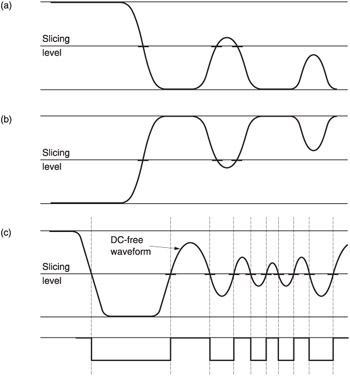
Figure 3.5: Slicing a signal which has suffered losses works well if the duty cycle is even. If the duty cycle is uneven, as at (a), timing errors will become worse until slicing fails. With the opposite duty cycle, the slicing fails in the opposite direction as at (b). If, however, the signal is DC free, correct slicing can continue even in the presence of serious losses, as (c) shows.
At (b) the opposite duty cycle is shown. The signal level drifts to the opposite polarity and once more slicing is impossible . The phenomenon is called baseline wander and will be observed with any signal whose average voltage is not the same as the slicing level.
At (c) it will be seen that if the transmitted waveform has a relatively constant average voltage, slicing remains possible up to high frequencies even in the presence of serious amplitude loss, because the received waveform remains symmetrical about the baseline.
It is clearly not possible simply to serialize data in a shift register for so-called direct transmission, because successful slicing can only be obtained if the number of ones is equal to the number of zeros; there is little chance of this happening consistently with real data. Instead, a modulation code or channel code is necessary. This converts the data into a waveform that is DC-free or nearly so for the purpose of transmission.
The slicing threshold level is naturally zero in a bipolar system such as a cable. When the amplitude falls it does so symmetrically and slicing continues. The same is not true of optical fibres in which the receiver responds to intensity and therefore produces a unipolar output. If the received waveform is sliced directly, the threshold cannot be zero, but must be some level approximately half the amplitude of the signal as shown in Figure 3.6(a).
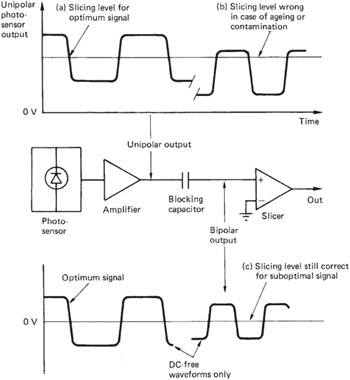
Figure 3.6: (a) Slicing a unipolar signal requires a non-zero threshold. (b) If the signal amplitude changes, the threshold will then be incorrect. (c) If a DC-free code is used, a unipolar waveform can be converted to a bipolar waveform using a series capacitor . A zero threshold can be used and slicing continues with amplitude variations.
Unfortunately when the signal level falls due to losses, it falls towards zero and not towards the slicing level. The threshold will no longer be appropriate for the signal as can be seen at (b). This can be overcome by using a DC-free coded waveform. If a series capacitor is connected to the unipolar signal from an optical receiver, the waveform is rendered bipolar because the capacitor blocks any DC component in the signal. The DC-free channel waveform passes through unaltered. If an amplitude loss is suffered, (c) shows that the resultant bipolar signal now reduces in amplitude about the slicing level and slicing can continue.
The binary waveform at the output of the slicer will be a replica of the transmitted waveform, except for the addition of jitter or time uncertainty in the position of the edges due to noise, baseline wander, intersymbol interference and imperfect equalization.
Binary circuits reject noise by using discrete voltage levels which are spaced further apart than the uncertainty due to noise. In a similar manner, digital coding combats time uncertainty by making the time axis discrete using events, known as transitions, spaced apart at integer multiples of some basic time period, called a detent, which is larger than the typical time uncertainty. Figure 3.7 shows how this jitter-rejection mechanism works. All that matters is to identify the detent in which the transition occurred. Exactly where it occurred within the detent is of no consequence.
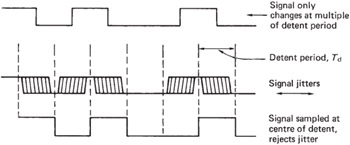
Figure 3.7: A certain amount of jitter can be rejected by changing the signal at multiples of the basic detent period T d .
As ideal transitions occur at multiples of a basic period, an oscilloscope, which is repeatedly triggered on a channel-coded signal carrying random data, will show an eye pattern if connected to the output of the equalizer. Study of the eye pattern reveals how well the coding used suits the channel. In the case of transmission, with a short cable, the losses will be small, and the eye opening will be virtually square except for some edge-sloping due to cable capacitance . As cable length increases , the harmonics are lost and the remaining fundamental gives the eyes a diamond shape.
Noise closes the eyes in a vertical direction, and jitter closes the eyes in a horizontal direction, as in Figure 3.8. If the eyes remain sensibly open , data separation will be possible. Clearly, more jitter can be tolerated if there is less noise, and vice versa. If the equalizer is adjustable, the optimum setting will be where the greatest eye opening is obtained.
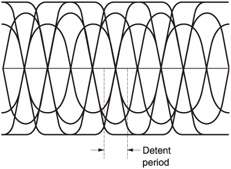
Figure 3.8: A transmitted waveform will appear like this on an oscilloscope as successive parts of the waveform are superimposed on the tube. When the waveform is rounded off by losses, diamond-shaped eyes are left in the centre , spaced apart by the detent period.
In the centre of the eyes, the receiver must make binary decisions at the channel bit rate about the state of the signal, high or low, using the slicer output. As stated, the receiver is sampling the output of the slicer, and it needs to have a sampling clock in order to do that. In order to give the best rejection of noise and jitter, the clock edges that operate the sampler must be in the centre of the eyes.
As has been stated, a separate clock is not practicable in recording or transmission. A fixed-frequency clock at the receiver is of no use. Even if it were sufficiently stable, it would not know the phase at which to run.
The only way in which the sampling clock can be obtained is to use a phase-locked loop to regenerate it from the clock content of the selfclocking channel-coded waveform. In phase-locked loops , the voltagecontrolled oscillator is driven by a phase error measured between the output and some reference, such that the output eventually has the same frequency as the reference. If a divider is placed between the VCO and the phase comparator, the VCO frequency can be made to be a multiple of the reference. This also has the effect of making the loop more heavily damped. If a channel-coded waveform is used as a reference to a PLL, the loop will be able to make a phase comparison whenever a transition arrives and will run at the channel bit rate. When there are several detents between transitions, the loop will flywheel at the last known frequency and phase until it can rephase at a subsequent transition. Thus a continuous clock is re-created from the clock content of the channel waveform. In a recorder, if the speed of the medium should change, the PLL will change frequency to follow. Once the loop is locked, clock edges will be phased with the average phase of the jittering edges of the input waveform. If, for example, rising edges of the clock are phased to input transitions, then falling edges will be in the centre of the eyes. If these edges are used to clock the sampling process, the maximum jitter and noise can be rejected. The output of the slicer when sampled by the PLL edge at the centre of an eye is the value of a channel bit. Figure 3.9 shows the complete clocking system of a channel code from encoder to data separator.
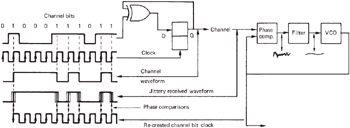
Figure 3.9: The complete clock path of a channel coding system.
Clearly, data cannot be separated if the PLL is not locked, but it cannot be locked until it has seen transitions for a reasonable period. In interfaces, transmission can be continuous and there is no difficulty remaining in lock indefinitely. There will simply be a short delay on first applying the signal before the receiver locks to it.
One potential problem area that is frequently overlooked is to ensure that the VCO in the receiving PLL is correctly centred. If it is not, it will be running with a static phase error and will not sample the received waveform at the centre of the eyes. The sampled bits will be more prone to noise and jitter errors. VCO centring is considered in Chapter 8. Many interface receivers have such an adjustment, although recent receiving chip sets may incorporate self-adjustment.
| | ||
| | ||
| | ||
EAN: 2147483647
Pages: 120
- ERP System Acquisition: A Process Model and Results From an Austrian Survey
- The Second Wave ERP Market: An Australian Viewpoint
- Healthcare Information: From Administrative to Practice Databases
- Relevance and Micro-Relevance for the Professional as Determinants of IT-Diffusion and IT-Use in Healthcare
- Development of Interactive Web Sites to Enhance Police/Community Relations